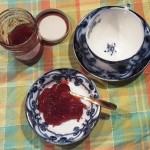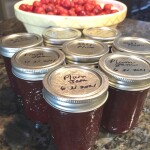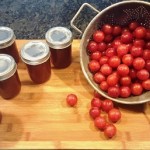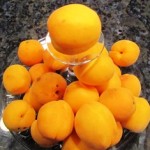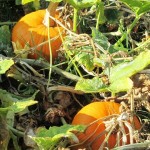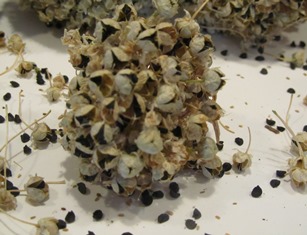How to Make Wild Plum Jam
A favorite breakfast on our farmette includes hot bread (like biscuits or popovers), slathered in butter and spread with homemade jam. We have many fruit trees from which to make jam but we love the sweet tartness of wild plums. These wild plums are smaller than regular plums or apricots, so you’ll need to pick enough to fill about a gallon-size bucket.
You’ll love this delicious jam spread on almost any kind of bread, roll, or cracker. Serve it alongside some firm breakfast cheese or your favorite goat cheese. Because of the balance between sweet and tart flavors, it greatly enhances the taste of roast pork or chicken, too.
Making wild plum jam doesn’t require a lot of skill. But you will need some simple kitchen tools like a tall pan (like a soup pot), a large bowl, measuring spoons, a colander, long-handle wooden spoon (for stirring hot jam), and a paring knife.
Required items include a hot-water canner, six or seven preserving jars with lids and rings, and a jar-filling cup, a jar lifter, a foam skimmer, and a magnetized ring lifter. If you don’t already have them, purchased these items in a hardware or diy store where canning jars and utensils are sold.
The PREP steps:
1. Start by picking the fruit and sorting out those plums with blemishes or bird pecked holes.
2. Wash the fruit.
3. Remove the stones. (I use a big bowl for this so I can save the pitted plums along with their juice to make the jam).
The JAM COOKING process.
1. Place 5 cups pitted plums with their juice in a large, deep pot.
2. Squeeze juice of one-half lemon into the pot.
3. Add 4 cups sugar. Stir to mix the ingredients.
4. Bring to a boil and stir constantly for 15 to 20 minutes or until the gel stage is reached. Skim off foam, if necessary.
5. Slowly and carefully stir in five tablespoons of Classic Pectin powder. Mix well. (You can test the gel consistency using a metal spoon chilled in the freezer. The jam should slowly roll to the edge and hang together instead of running off like water.) Remove jam pot from heat.
6. Ladle the hot jam into sterilized jars. Place a lid on each jar and then screw on the rings.
7. Place in the boiling water of a hot-water canner and process for 15 minutes.
8. Remove each jar of jam and listen for the pop of each lid. Let cool in a draft-free area. Label and store.
_____________________________________________________________________
Enjoy reading about country living and farm topics? Check out my cozy mystery novels that include tips and strategies for successful, country living or my nonfiction books on health and spiritual wholeness.
All are available with a search of my name–Meera Lester–on Amazon.com, barnesandnoble.com, and other online and brick-and-mortar bookstores everywhere.
Also, take a look at my wellness and spirituality books for living your best life now. All are available online and wherever books are sold.

More than 150 rituals for sound mind, strong body, and meaningful connections to the people around you
See, https://www.amazon.com/Rituals-Life-Meaning-Everyday-Moments/dp/1507205244
Bless Others with Your Backyard Bounty
I called my neighbor just after sunup this morning and asked her to come help me pick plums. I have trees of ripe plums, three different varieties, as well as apricots that are ripening too fast for me to keep up with drying and jam-making.
She came laden with a dozen boxes. I had ladders and buckets and bowls ready. We were soon joined by her husband who also brought a ladder. We picked until the containers were full and still the trees held a ton of fruit.
He backed up their van and we loaded the fruit containers inside. They would drive the containers full of fruit to our local food pantry–the Contra Costa County Food Bank Warehouse at 4010 Nelson Avenue in Concord to distribute to needy families.
Saying thanks didn’t seem adequate enough, so I took my neighbors to my veggie patch to find some items just for them. I promised to deliver pumpkins when they were ready but for now we found heirloom zucchini, summer squash, and tomatoes.
Their gift of time and energy spent picking and packing fruit and delivering it to the food bank freed me up to start my jam-making. A friend once told me that what blesses one blesses others. It certainly proved true today.
If you’re interested in donating fresh food from your backyard garden, contact the Contra Costa Food Bank warehouse, located at 4010 Nelson Avenue, Concord, CA 94520 or call 925. 676.7543. Hours are Monday through Thursday: 7 a.m. to 7 p.m. Friday: 8 a.m. to 3 p.m. Saturday and Sunday: 8:00 a.m. to 3:30 p.m.
If you don’t have lovely, helpful neighbors who will assist you harvesting your bounty, contact gleaners in Contra Costa County at www.theurbanfarmers.org
_____________________________________________________________
If you enjoy reading this blog about my Henny Penny Farmette activities, check out my cozy mystery series (A BEELINE TO MURDER, MURDER OF A QUEEN BEE, and A HIVE OF HOMICIDES) as well as my current nonfiction books.
All are available online at Amazon, Barnes and Noble, and Walmart as well as traditional bookstores everywhere. The cozy mysteries are chocked full of delicious farmette recipes, tips of keeping honeybees and chickens, and farm trivia.
Busy Bees and Abundant Rain Spell Bumper Crops in the Orchard
Thanks to the drought-ending rain and the robust activity of our honeybees, my orchard has produced a phenomenal crop of cherries, apricots, and plums this year.
I picked some wild plums today. They’re unusually sweet so I will make them into jam this week. I think the apricots will be ready next week. Today, I’m getting ready for jam-making by taking down cases of canning jars from the storage shelf over the washer and dryer. I’ll need to get lemons, bags of sugar, pectin, and jar lids.
The vegetable garden is also benefiting from bee activity. The summer Italian striped squash and the crooked neck squash plants are producing squash faster than we can eat them. The tomato vines are loaded, and I expect the corn to be ready soon, too.
Nothing beats fresh summer jams to brighten a dreary winter morning. This summer, I hope to make enough to last through 2017 winter into next spring. This past winter, I ran out of apricot jam because it is the one most of our neighbors, family, and friends prefer. But thanks to the rain and the bee activity, running out of jam won’t be a problem for next year.
____________________________________________________
Like my honeybees, I’ve been busy this winter/spring, writing two nonfiction books for readers who embrace the path of yoga, healthy living, meditation, meaningful ritual, and mindfulness. To be released this year: My POCKET MEDITATIONS (July 2017) and MY DAILY RITUALS (Christmas 2017).
Check out MY POCKET MEDITATIONS, the newest forthcoming nonfiction title from Adams Media/Simon & Schuster, at http://tinyurl.com/l6lzorq
![My Pocket Meditations: Anytime Exercises for Peace, Clarity, and Focus by [Lester, Meera]](https://images-na.ssl-images-amazon.com/images/I/51GH%2BXEPc6L.jpg)
COMING SOON: My newest offering in the Henny Penny Farmette mystery series, A HIVE OF HOMICIDES (Kensington Publishing, Sept. 2017).
Winter Solstice Day
It’s that time of the year when we mark the shortest day of the year, the beginning of winter, and the return of the light. I like to think of it as a day when I decide what I do and don’t want to take with me into the coming New Year.
We’ve had a run of cold nights with temperatures in the upper 20 degrees Fahrenheit. But the light will soon return and warm the Earth. Late January-early February marks the beginning of bare-root season. My work now includes pruning and spraying and clearing out the old to make way for rebirth and renewal.
Among the plants that renew are the fruit trees. The pruned branches, garden clippings, and old vines are being recycled into compost for next spring’s garden. Come late spring, I’ll have trees with gorgeous canopies and tons of fruit to make into jam.
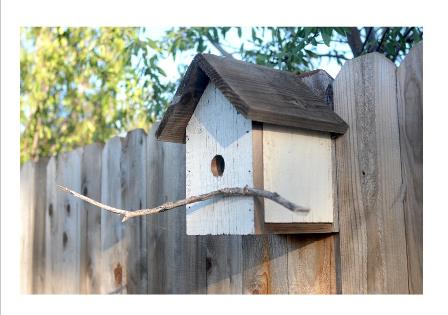
This DIY birdhouse is crafted from a repurposed fence board. Not all birds will take up residence in a house, but many will.
Garlic and onions are growing now and will through the winter months, thanks to our mild Mediterranean climate. But there is so much cleanup of the property that needs doing, I can only hope to start that today.
I’m putting out seed balls for the birds as well as refilling feeders and suet holders. Easy-to-find food keeps our feathered songsters around through spring when they start their families. For directions on making a birdhouse for your garden, check out https://hobbyreads.wordpress.com/category/crafts.
*******************************************************************************************************************************************************
Enjoy reading about farming topics? Check out my cozy mysteries–A BEELINE TO MURDER and also THE MURDER OF A QUEEN BEE (both in the Henny Penny Farmette series from Kensington Publishing).
JOIN THE CHRISTMAS EVE FUN–Read a short excerpt from my newest book, THE MURDER OF A QUEEN BEE and check out blogger Brooke Bumgardner’s interview of me at http://www.brookeblogs.com
My farmette and bee-based novels are chocked full of recipes, farming tips, chicken and beekeeping tips, sayings and, of course, a charming cozy mystery. For more info, click on the links under the pictures.
The books are available through online retailers such as Amazon, Barnes & Noble, Target, BAM, Kobo Books, and Walmart as well as from traditional bookstores everywhere.
See, http://tinyurl.com/hxy3s8q
This debut novel launched the Henny Penny Farmette series of mysteries and sold out its first press run. It’s now available in mass market paperback and other formats.
See, http://tinyurl.com/h4kou4g
NEWLY RELEASED! This, the second cozy mystery in the Henny Penny Farmette series, is garnering great reviews from readers and industry publications. Get your copy while you can. It’s sure to sell out like novel #1.
Gathering Seed for Next Year’s Garden
The sounds of summer around our farmette have grown quieter. It’s mid-August and the neighborhood children have returned to school. I miss their laughter. I miss the delight on their faces at seeing the chickens and the honeybees. I miss keeping them company at their lemonade stand.
But I admit to the secret pleasure of solitude and quiet, though it isn’t really silence. It’s the peaceful clucking of chickens and the twitter of songbirds as I gather seed from plants that have bloomed and dried, such as the cosmos, nasturtiums, sunflowers, and wisteria.
The wisteria vine that exploded in growth of long, green tendrils during spring and early summer and graced us with bracts of purple perfusion now hold heavy pods. The pods contain seeds that can be dried and planted for new vines next year.
The sword-shaped leaves of the irises are dry–their blooms a memory from early spring. I’ve already cut their long leaves back into four-inch fans and will dig some of the rhizomes for replanting in other beds around the farmette.
The sunflowers that the bees love to forage on have gone to seed. Those seeds will become next year’s plants, but some we’ll save for the squirrels.
The red and yellow onions have developed seed pods on long shoots now. I’ll plant those in raised beds in the fall for a spring crop of onions.
Yes, the dog days of summer have come around again. But the growing season continues. End of summer gives rise to autumn when grapes, persimmons, pumpkins, figs, and pomegranates ripen. On the farmette, there is always another season and other crops to look forward to with anticipation. It’s the good life.
Backyard Fruit Compote
Who feels like eating when the shorts and sandals weather has turned hot enough to warrant wearing bikini bottoms and thin cotton T-shirt for doing your household chores? Bring on the cool summer salads.
When the temperatures hit 105 on the farmette yesterday, we opted for a simple supper of cold chicken, orzo with Italian vinegar and oil dressing, and cold potato salad.
With nectarines and peaches ripening now on our trees, blueberries finally sweet enough to eat, and strawberries available at our local farmers’ market, what could be better for a dessert on a hot summer’s evening than a fruit compote.
Recipe for Backyard Fruit Compote
Gather the fruit, including nectarines, peaches, plums, strawberries, blueberries, kiwi, and melon.
Wash, and slice the nectarines, peaches, plums, and strawberries.
If including melon in the compote, scoop the melon into ball shapes using a melon baller or cut pieces of melon into cubes.
Peel and slice the kiwi.
Toss all into a bowl, adding the blueberries.
Sprinkle lightly with a scented sugar, or a super fine sugar, or honey.
Or, make a dressing: mix together 1/4 cup of lime juice, 1/4 cup of honey, 1 teaspoon of orange zest, 1 teaspoon of lime zest, and 1/2 teaspoon finely grated ginger. Pour over the fruit. Chill for about 1 hour and add springs of mint before serving.
Rustic Pluot or Plum Tart with Italian Crostata Crust
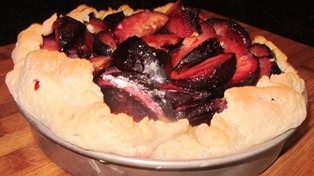
Pluots or plums are first drizzled in lemon juice and dusted with flour, then placed into the tart with bits of butter
The farmer’s market has the dark purple-black plums and pluots in abundance now, so I thought I’d buy a few and whip up a rustic summer tart, Italian style.
I like the rustic tarts with the Italian style crostata crust because they are easy to make and the tart tastes so buttery and flaky. This recipe uses butter and also cream cheese that gives the tart a special lightness. For the filling, I used pluots for this one, but you could also use ripe plums.
To make the dough, I find it easier to just put the ingredients into the food processor with a steel blade and pulse a few times, adding ice water as needed.
Ingredients:
8 ounces cream cheese
2 sticks butter (1 cup)
2 cups flour
½ teaspoon salt
1 teaspoon cold water
6-7 large sweet pluots or dark plums
Juice from ½ medium lemon
2 Tablespoons butter
2 Tablespoons flour
Directions:
Preheat oven to 375 degrees Fahrenheit.
In a food processor with blade, process cream cheese, butter, flour, salt, and water into a ball.
*Roll out on a lightly floured surface in a circle to about ¼ inch thickness and 2-4 inches larger than your tart pan.
Place dough in a tart pan and pre-bake 10 minutes.
Wash, cut, stone, and cut pluots/plums into quarters.
Combine with lemon juice.
Toss with flour. If plums are juicy, you’ll need a bit more flour to absorb all that juice.
Cut butter into pieces and scatter around the plums as you layer the slices in the pan on top of the crostata dough.
Fold extra dough loosely back over the plums; it should not reach the center because you want a rustic look to the baked tart.
Bake for 30-45 minutes until pluots/plums are soft and dough is golden brown.
Serve warm with a dollop of whipping cream or a good vanilla ice cream.
*Avoid over-handling the dough as it will become tough.
 Facebook
Facebook Goodreads
Goodreads LinkedIn
LinkedIn Meera Lester
Meera Lester Twitter
Twitter





